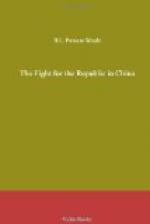It would take too long, and would weary the indulgence of the reader to establish in a conclusive manner this thesis which had long been a subject of inquiry on the part of political students. Chinese society, being essentially a society organized on a credit-co-operative system, so nicely adjusted that money, either coined or fiduciary, was not wanted save for the petty daily purchases of the people, any system which boldly clutched the financial establishments undertaking the movement of sycee (silver) from province to province for the settlement of trade-balances, was bound to be effective so long as those financial establishments remained unshaken.
The best known establishments, united in the great group known as the Shansi Bankers, being the government bankers, undertook not only all the remittances of surpluses to Peking, but controlled by an intricate pass-book system the perquisites of almost every office-holder in the empire. No sooner did an official, under the system which had grown up, receive a provincial appointment than there hastened to him a confidential clerk of one of these accommodating houses, who in the name of his employers advanced all the sums necessary for the payment of the official’s post, and then proceeded with him to his province so that moiety by moiety, as taxation flowed in, advances could be paid off and the equilibrium re-established. A very intimate and far-reaching connection thus existed between provincial money-interests and the official classes. The practical work of governing China was the balancing of tax-books and native bankers’ accounts. Even the “melting-houses,” where sycee was “standardized” for provincial use, were the joint enterprises of officials and merchants; bargaining governing every transaction; and only when a violent break occurred in the machinery, owing to famine or rebellion, did any other force than money intervene.
There was nothing exceptional in these practices, in the use of which the old Chinese empire was merely following the precedent of the Roman Empire. The vast polity that was formed before the time of Christ by the military and commercial expansion of Rome in the Mediterranean Basin, and among the wild tribes of Northern Europe, depended very largely on the genius of Italian financiers and tax-collectors to whom the revenues were either directly “farmed,” or who “assisted” precisely after the Chinese method in financing officials and local administrations, and in replenishing a central treasury which no wealth could satisfy. The Chinese phenomenon was therefore in no sense new; the dearth of coined money and the variety of local standards made the methods used economic necessities. The system was not in itself a bad system: its fatal quality lay in its woodenness, its lack of adaptability, and in its growing weakness in the face of foreign competition which it could never understand. Foreign competition—that was the enemy destined to achieve an overwhelming triumph and dash to ruins a hoary survival.




